Body and Soul is the old science-fiction staple, the body swap episode.
There are any number of iconic examples of the genre, even within the larger Star Trek franchise. Although the original series was populated with duplicates and doppelgängers and surrogates and clones in episodes like The Enemy Within, Mirror, Mirror, Whom Gods Destroy and even What Are Little Girls Made Of?, Turnabout Intruder might be the most straightforward example. Star Trek III: The Search for Spock featured sequences in which McCoy was channelling Spock. Star Trek: Deep Space Nine had all the cast take on the personalities of Dax’s past hosts in Facets.

Insert your cheesecake jokes here.
Often, these sorts of stories exist to showcase the dramatic range of key performers and to offer a little variety to the weekly routine of playing the same character for years and years on end. On Star Trek: The Next Generation, Brent Spiner would occasionally find himself tasked with playing Data’s “brother” Lore or his “father” Noonien Soong in episodes like Datalore, Family, Descent, Part I, Descent, Part II and Inheritance. The cast on Deep Space Nine would play their mirror counterparts in stories like Crossover, Through the Looking Glass and Shattered Mirror.
Even Star Trek: Voyager has done its own body swap and possession narratives before, like with Tuvok in Cathexis or with Paris in Vis à Vis. However, the success of these sorts of episodes largely rests in the execution, in the question of whether it is worth watching a familiar actor playing an unfamiliar role for forty-five minutes. This is a tough challenge, and many episodes falter trying to hit that mark. Body and Soul has a lot of very fundamental issues with it, but it at least has the common sense to ask one of the cast’s best actors to impersonate another of the cast’s best actors.

“Next week is a Kim episode?”
On a fundamental level, Body and Soul exists to showcase the acting talents of Jeri Ryan. The entire episode is predicated on Ryan playing a comedy of manners in the mode of her co-star Robert Picardo. This is a logical extension of past episodes that have seen Jeri Ryan extend her performance on the series outside the rigidly-defined character of Seven of Nine, most notably when asked to play an entire menagerie of previously unseen characters in Infinite Regress.
This is a staple of Star Trek production, particularly with actors playing iconic and beloved characters who might want to stretch beyond this. The character of Seven of Nine on Voyager has been likened to the character of Data on The Next Generation, even by producer Brannon Braga. This extends beyond their role in the ensemble. Both Seven of Nine and Data are relatively stiff characters, and are distinct from a lot of other characters in popular culture. It makes sense that the actors playing the roles might be anxious about being typecast, and would want to show range.
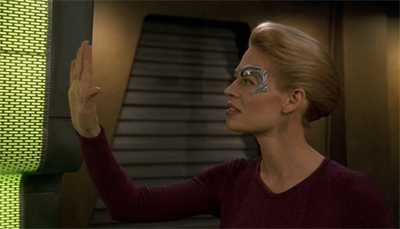
A force field to be reckoned with.
In the later seasons of The Next Generation, there are entire episodes built around letting Brent Spiner play against type. In A Fistful of Datas, the actor gets to play an entire village inside Alexander’s western holodeck fantasy. In Masks, Data takes on the varied personalities of an entire extinct civilisation. These creative choices are designed to showcase the actor’s range, serving the triple function of giving a fan favourite more to do, giving the actor more variety in their work, and offering them an opportunity to showcase their range.
Body and Soul is essentially a forty-five minute acting exercise, with Jeri Ryan playing Robert Picardo playing the EMH, who is occasionally playing Seven of Nine. It’s a demanding premise for a performance, and it requires two strong actors to pull it off; Ryan most obviously has to impersonate Picardo, but Picardo’s performance has to be strong enough to lend itself to imitation. This is a way of showcasing a strong performer in the ensemble. It is perhaps revealing that Kate Mulgrew, the other contender for strongest actor in the cast, gets her turn in Renaissance Man.

A static figure.
“I saw a lot of Jeri’s performance, and it was great,” the actor continues. “I was delighted that she went out on such a limb, because this is really going to impress people with her comic skills — people are going to see that she’s quite a comedian.” Yet Picardo enjoyed the serious side of the episode, the Doctor’s first experience as an organic being. “The Doctor is learning about sensual indulgence, and he basically dresses Seven down for not smelling the roses, for not enjoying anything about being alive. Tasting food for the first time, getting drunk for the first time, feeling his lungs fill with air, in Seven’s body. I’m not going to say ‘And what a set of lungs!’ because all the jokes have been made.”
This emphasis on range is important, given that Voyager is winding down. Star Trek actors do not always successfully transition out of the franchise, especially those in iconic roles.
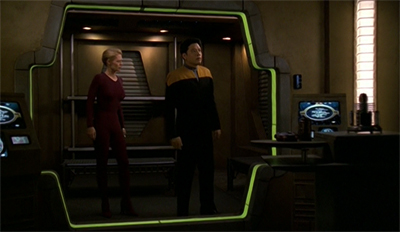
Celling it very well.
To her credit, Ryan has arguably enjoyed a stronger post-Voyager career than any of her co-stars. Ryan enjoyed a three-season stint on Boston Public immediately following the end of Voyager and has enjoyed regular film and television work since; her credits include Shark, Body of Proof and Bosch. Although Mulgrew and Picardo were relatively well known going into Voyager, Ryan emerged from the series as the breakout actor. And deservedly so.
Although the character of Seven of Nine is divisive among Star Trek fans, and although the concept is hampered by a number of cynical creative choices designed to emphasise her status as a potential sex symbol, Ryan is a fantastic performer. Along with Mulgrew and Picardo, Ryan towers over the rest of the ensemble. This is very apparent within Body and Soul. It is a credit to Ryan that she so skillfully plays Picardo-as-the-EMH-as-Seven that the audience figures out what is happening even before she explains it to Kim in the holding cell. It is remarkable.

“A little less intense, maybe?”
Ryan is not the only Voyager cast member who is consciously preparing for a career after the end of Voyager. Body and Soul is notable as the fourth episode of Voyager to be directed by actor Robert Duncan MacNeill, following on from Sacred Ground, Unity and Someone to Watch Over Me. In an interview with Starlog, McNeill had already decided to focus on directing after Voyager:
“I was thrilled that I got to direct once more. It’s a very delicate subject for our producers and the studio, I’m sure, allowing actors to direct. You don’t want to open the floodgates and have everyone think they can direct episodes, or it will just get out of hand. So it was real nice of them to let me do my fourth episode. I can’t speak for any of the other actors, but I think they realized that I’ve made a couple of short films during Voyager’s run, I produced a TV movie last year. I directed for Nickelodeon. They could see my seriousness about directing, that directing will probably be a big part of what I do after the series ends. So maybe they’ve rewarded that, and it has been great. I’m very grateful for the opportunities.”
In fact, McNeill would also direct four standout episodes of Star Trek: Enterprise, including the first season episode Cold Front and the third season time travel story Twilight. He would also be trusted to direct Countdown, the action-driven penultimate episode of the Xindi arc.

Glowing reviews.
Along with frequent scene collaborator Roxanne Dawson and Next Generation star Jonathan Frakes, McNeill would move behind the scenes following his seven-year tenure on Voyager. MacNeill would become a producer and director, notable for his work as an executive producer on cult comedy Chuck and as a director on series like The Girlfriend’s Guide to Divorce or The Mentalist. There is a sense that, like Ryan, McNeill is consciously preparing for life after his stint on Voyager.
McNeill is a very good director. There are a number of subtly understated and impressive shots within Body and Soul, to the point that it feels like a (very confident) directorial showreel. Even in the teaser, there are a number of impressive compositions for what amounts to little more than an exposition scene. There is a shot where the EMH is holding a sample to a door that Seven then walks through, creating nice continuity. There is an impressive one-take sequence in which the EMH monologues about life, with the camera following and pushing in on him.
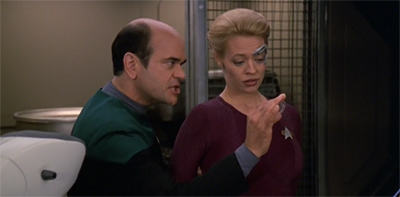
What does it take?
The biggest issue with Body and Soul is that there is very little supporting these two core elements. The script simply isn’t worthy of either Ryan’s performance or McNeill’s direction. This is not to say that Body and Soul is terrible. It is far from the worst episode of the seventh season, despite some very awkward creative choices. Instead, Body and Soul is just limp. This is a script that never chooses the more interesting or the more challenging path to its destination, leaving its central actor to carry most of the weight.
In its own way, this speaks to a sense that the writers on staff are also getting ready for the end of Voyager. After all, Rick Berman and Brannon Braga have all but given up on Voyager, turning their attention to the development of Enterprise. Kenneth Biller is running the day-to-day production on the series, and has adopted a very archetypal paint-by-numbers approach to storytelling, the ultimate conclusion of Voyager‘s approach to Star Trek storytelling. The seventh season of Voyager believes that it is enough to look like Star Trek, without exploring it.
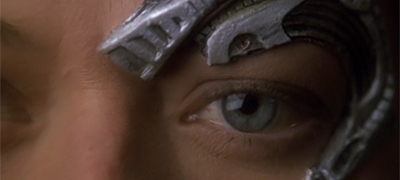
An eye-opening experience.
Despite a story credit given to staff writer Micheal Taylor, Body and Soul was largely overseen by writers outside of the established writing staff. As Bryan Fuller explained to Cinefantastique:
“We had a freelance writer write [Body and Soul], and then Phyllis Strong and Mike Sussman came in to rewrite it and did a fantastic job. That episode had a certain levity to it that I think was quite nice. Jeri was amazing; she nailed Bob Picardo. The episode was either going to succeed or fail on her performance. I think because her performance was so great, the episode was a success.”
This is disappointing. Normally an episode like Body and Soul would receive a significant re-write or direction from a lower-ranking staff writer like Fuller or Taylor.
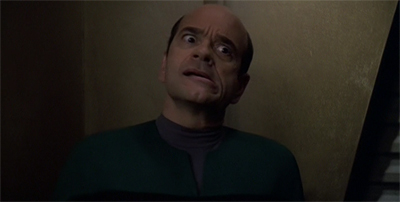
What’s up, doc?
Mike Sussman had previously worked on episodes like Meld, The Swarm, The Haunting of Deck Twelve, Unimatrix Zero, Part I and Unimatrix Zero, Part II, but he was still somewhat untested. Body and Soul is the first Star Trek teleplay to be credited to Strong, whose most notable credit to that point was an episode of Hercules: The Legendary Journeys. Both Sussman and Strong would join the writing staff in the final season of Voyager, and would be the first writers recruited by Brannon Braga to work on Enterprise.
Again, there is a sense that everything about the seventh season of Voyager is looking either to the finish line or beyond the end of the show. For all that the title and concept of Voyager suggest that the series is supposed to be about the journey, the seventh season has fixated on the destination. More than that, it hasn’t even bothered to chart a course. The seventh season of Voyager feels like the work of people who know on a fundamental level that the series can coast into its ending without any major hurdles or complications.

Drinking it in.
“That was their first script,” says McNeill, “and they are now staff on the show. They were really thrilled and pleased. Every once in awhile you have these episodes where as the dailies are coming in people get more and more excited about it, and things are coming off better than anyone could have expected or hoped for. That’s kind of the experience I think we had on that episode. There was a really high spirit about it.
“I think it’s going to be one of the couple of episodes that’s going to be a classic from our show. It’s really that strong. They are bumping it up and pushing it for November sweeps, trying to finish it up and get it ready for Nov. 15. It was a broad comedy, which we don’t often do. We were as successful as Star Trek has ever been with a comedy like that. It’s funny. It’s fast-paced. It’s entertaining. I think for the fans who really watch the show a lot, they will certainly get more out of it than people who don’t know the show. But even if you don’t know the show, you still get the humor and the spirit, and it’s still very entertaining.”
Sussman and Strong are a very late addition to Voyager, and perhaps should instead be considered very early recruits for Enterprise.

A screaming success…
Allowing for this, Body and Soul feels like a story that was consciously outsourced by the writing staff and developed with relatively little supervision. This may explain the clumsiness of certain plotting decisions and the awkwardness around certain developments. Body and Soul is an episode that works largely on autopilot, hitting most of the marks expected in body-swap comedy without elaborating on them in any real depth.
There are a couple of moments when Body and Soul tips from being functional into being bad, but these are often a result of laziness rather than malice. Body and Soul plays not one but two “gay panic!” jokes using the premise of a male hologram inside a female cyborg’s body. Most immediately, the episode plays the idea of Ranek’s attraction to EMH-as-Seven as a broad joke of the “look, this manly man is sexually attracted to a dude!” variety. Then the EMH-as-Seven’s attraction to Jaryn is also played as a joke of the “she has no idea her girlfriend is dude!” variety.
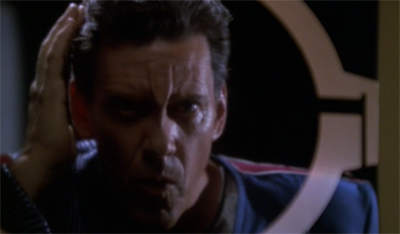
“‘Baby, they named you wrong when they called you Seven, because you’re a Ten to me.‘ Yeah, that’s the stuff. Still got it, Captain.”
These jokes are nowhere near as bad as they could be, ending with come level of understanding between the EMH and the two Lokirrin officers that suggests a more open-mindedness. However, it is more frustrating in the context of the larger Berman era, where Star Trek consistently and repeatedly refused to acknowledge the existence of same-sex relationships for fear of alienating conservative viewers. Even Deep Space Nine had to approach the issue obliquely in Rejoined and Chimera.
Some of the other issues with Body and Soul come as a result of simple carelessness in how the plot is structured. The episode needs an early act break, and so decides to pivot on the sequence in which the EMH removes himself from Seven’s consciousness. “You’ve had quite a shock to your system,” the EMH states. “Let me explain what’s happened.” Body and Soul cuts to commercial as the music rises and Seven of Nine responds, “I know exactly what’s happened. You’ve been abusing my body.”
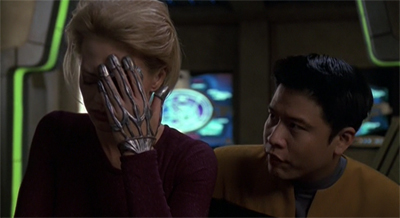
“Well, this took a turn.”
That is a very serious allegation to make, particularly in the context of a character like Seven of Nine. Since the end of Scorpion, Part II, Seven of Nine has been heavily sexualised. Her sexuality was the focus of a subplot in Revulsion. There are have been several points where violence against Seven of Nine has been coded in explicitly sexual terms, most notably in the threats made by Trajis in One or the repressed memory of assault in Retrospect. As such, it is not entirely outside-the-realm-of-possibility that Body and Soul could pivot in that direction.
It would certainly be a sharp left-turn for what had been a broad body swap comedy, and would serve to distinguish Body and Soul from many of the other entries in the subgenre like Vis à Vis. Certainly, the franchise has a history of coding mental interference as a profound (and often sexual) assault, most notably in Violations but also in episodes like Mind’s Eye. There are some interesting ideas to explore in this context, particularly against the backdrop of the late nineties when issues like consent and “date rape” were entering the public discourse.
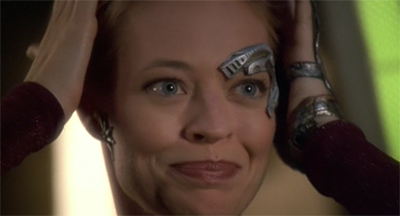
Getting into her head.
Of course, Body and Soul is not actually interested in exploring that idea, and so pivots back to the language of broad farce. The matter is dropped very quickly and never really raised again. It is a very strange diversion, one which articulates a lot of the creepy subtext that audiences need to ignore to enjoy a story like this. More than that, it is brought up for no better reason than because the episode needed a cliffhanger to get the audience across a commercial break. That cliffhanger is a spectacular misjudgement, equivalent to trying to kill a fly with a sledgehammer.
There are a number of problems with Body and Soul that result from the same awkward misjudged emphasis, as if the writers understand how to put a television episode together in terms of basic structure – the need for theme, exposition, act breaks, set-up – but cannot quite figure out how those structural elements apply to the story that they are telling. The weird sexual assault confrontation between Seven and the EMH is one such example, but there are other smaller examples within the episode.
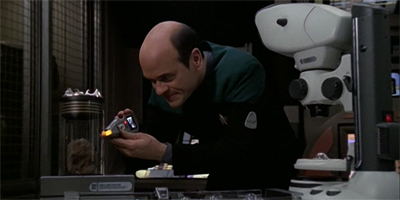
Yes. Living his best life.
The teaser is a great example. The EMH is waxing lyrical about his scientific studies to Seven of Nine, summoning her to the back of the ship so he can deliver a very stirring speech about the nature of life itself. “Someday, this cytoplasmic matrix may fall into the primordial sea of a distant world where it could ignite an evolutionary process. Eons from now, a creature not unlike you could emerge, look up at the stars and ask, who am I? How did I come to be? It’s the miracle of creation, Seven. Doesn’t that excite you?”
This sequence serves an important purpose, before the the Lokirrin ship arrives and the plot kicks into gear. It should establish the characters, it should set up their dynamic, it should foreshadow the theme of the larger episode. This is stock writing in general and television writing in particular. This is a formula that Michael Piller very effectively established in The Next Generation, when episode teasers would frequently feature the characters engaging in activities or having conversations that set up the rest of the episode.
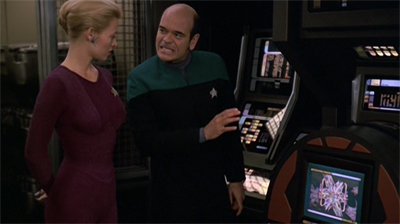
The real cytoplasmic matrix was the friends we made along the way.
In The Defector, Picard and Data are rehearsing Henry V, a play that handily sets up the themes (and even foreshadows some of the reveals) of the episode that is about to unfold. In A Matter of Perspective, Data joins Picard in an art class, which allows for a meditation on the idea that each individual can have a different perspective of the same objective object. Even in Yesterday’s Enterprise, Worf enjoys prune juice in Ten Forward, handily establishing what is lost when the timeline is rewritten moments later.
This is all basic storytelling, which Michael Piller codified ten years earlier. One of the big recurring tensions of both Voyager and the first two seasons of Enterprise is the sense that television itself moved beyond the wonderfully effective template that Michael Piller established in that third season. However, the later seasons of Voyager offer an even more worrying suggestion. It seems like Voyager has actually forgotten how to properly implement some of the most basic and useful writing guidelines established by one of the franchise’s most important producers.

The EMH lies very well.
The teaser in Body and Soul understands at a fundamental level that it needs to set up a conflict between the EMH and Seven of Nine, because those two characters are going to spend most of the episode together. Unfortunately, it doesn’t understand that the conflict in the teaser should in some way set up or mirror the theme of the episode as a whole. In theory, the EMH should be arguing in the teaser that Seven needs to enjoy life. In practice, he is arguing that she should spend more time analysing laboratory samples. It just does not connect.
The episode’s subplot also suffers from these same issues. Ideally, the primary plot should tie into (and reflect) the secondary plot of the episode. This is not a requirement, though, simply a nice dovetail. Both plots in Treachery, Faith and the Great River meditate on different notions of belief. Even the two plots in Someone to Watch Over Me focus on a restrained character letting their hair down. The two plots in Body and Soul are relatively disconnected, with the body swap comedy involving the EMH juxtaposed against the subplot involving Tuvok’s pon farr.

“He’s too farr pon.”
To a certain extent, this reflects the long-standing difficulty that Voyager has had with Tuvok as a character. After all, the show has found itself essentially repeating the same beats over and over for the franchise’s first full-blooded Vulcan character, with rare exceptions like Gravity. Indeed, episodes with subplots focusing on Tuvok especially struggle to do anything meaningful with the character, most notably the ill-judged subplot about how tired Tuvok is during Muse.
Nevertheless, there is something very egregious about the way in which Body and Soul uses Tuvok. After all, this is the one plot that Voyager is obligated to tell using the character. Amok Time established the pon farr as a biological phenomenon that affected every adult Vulcan once every seven years. When it came up again in The Search for Spock, it was heavily implied that it affected Vulcan males in particular. Given that Voyager was always likely to run for seven seasons, and given the premise of the series, the show was always going to have to tell this story.
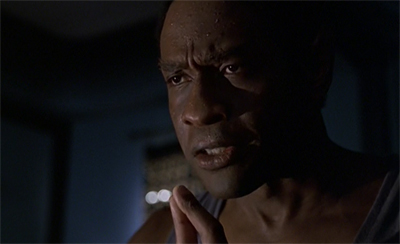
Whatever it (medi)takes.
Voyager has been notably reluctant to tell that particular story. When the series did an episode about pon farr with Blood Fever in the third season, it used a supporting guest character to infect Torres with something comparable to the pon farr while Tuvok observed from the sidelines. Similarly, the teaser to Tinker, Tenor, Doctor, Spy used Tuvok’s pon farr as a wry punchline. “Tuvok, you’ve gone without for seven years… about.”
In fact, pushing off the “Tuvok gets pon farr” plot into the final season of the show and burying it as a subplot reinforces this sense of reluctance. This is not a story that Voyager particularly wants to tell, and the positioning of it at one of the latest possible points in the show’s run and as a secondary subplot that never actually pays off in any meaningful sense contributes to a larger sense of pointlessness to all of this.

Soups you, sir.
This is a shame, as there are a lot of interesting ideas that could be explored using the pon farr as a metaphor; the question of sex and interpersonal relationships on a ship stranded decades from home, the question of love and fidelity as against biological impulse, even questions of abstinence. As Tim Russ outlined, there’s a lot of fertile ground and ambiguity to explore:
“What are all the particulars of this phenomenon?” demanded Russ. “What happens if the wife dies? If she’s human, she’s not even part of the whole ritual – she couldn’t have been betrothed to Sarek. And in the original story, the character says she can choose whether she takes him or not, so that’s not fixed. What else isn’t fixed? If you don’t go back to the planet, do you necessarily die if you don’t go through a fighting ritual or if you don’t take a mate? That’s what has to be determined, the ritual and the actual pon farr experience. If Tuvok is not on his home soil, will he perish if he does not perform some kind of ritual? Can he exist in that part of space for that many years without that kind of contact? What are the actual facts and what are the variations? We only have the basics, so that’s what has to be figured out in the story.”
However, Voyager is very uncomfortable dealing with any of these questions. Tuvok’s experiences are shunted into a subplot, dismissed with a few lines of dialogue, potentially solved by the holodeck. They are then interrupted, and eventually (implicitly) fulfilled. These are all just things that happen. There is no meaningful engagement on the point.

Toast of the town.
There are a number of reasons why Voyager might not have wanted to deal with a subplot involving Tuvok and the pon farr. Voyager could be a staggeringly conservative series at times, as demonstrated by episodes like Real Life. The series might not have felt comfortable dealing with sex in as candid a manner as an episode like Amok Time would demand. In fact, Blood Fever seems to suggest as much, an episode much more interested in exploring violent solutions to the crisis than sexual ones.
More than that, there is a broader anxiety around Tuvok’s sexuality in particular. Voyager has repeatedly coded Tuvok as a queer character, largely through the sexual subtext of the mind meld. Tuvok’s use of the mind meld against male characters in episodes like Meld, Random Thoughts and Repression are all coded as implicitly sexual (and sexually violent) in nature. However the series retreats from any notion of Tuvok as sexually active. It should be noted that Enterprise has no compunction against T’Pol through the pon farr as early as Bounty at the end of the second season.

“You know, the slash writers are having a field day right now.”
Body and Soul makes a very casual nod towards the complications facing Tuvok as a Vulcan experiencing pon farr in the Delta Quadrant. Paris suggests using the holodeck to quell Tuvok’s desires. Tuvok is understandably uncomfortable with the idea. “It’s the holodeck, Tuvok,” Paris assures him. “It doesn’t count.” Tuvok replies, “Is that what you tell your wife?” Paris admits, “No, of course not. My days of rescuing slave girls from Planet Ten are history.”
Paris suggests a compromise. “Look, you have photographs of your wife, right? The computer can use them to create a replica. You wouldn’t be breaking your vows if it’s a hologram of your wife.” This is a superficial solution to the issue, but it also just raises more questions. In Blood Fever, Vorik is not sated by a holographic lover. More than that, episodes like Meridian have broached the issues of consent when it comes to duplicating people (especially women) for personal (especially sexual) purposes on the holodeck.

Take his wife, please.
Of course, all of these problems can be handwaved. Of course Tuvok’s wife would probably consent to her image being used to save her husband’s life. Maybe the holodeck works better for Tuvok than for Vorik because Tuvok is older and so has more control of his impulses, despite the fact that “unlike in humans, the Vulcan libido increases with time.” However, none of these issues are actually acknowledged, even in passing.
Instead, the Tuvok subplot is a punch of stuff that happens, which struggles greatly with tone. Tuvok is about to have sex with a hologram, something that the episode implies that he sees as equivalent to cheating, but the moment isn’t allowed to play out. It is interrupted but the arrival of the Lokirrim, in a beat that seems designed to play as mean-spirited romantic comedy; Tuvok is about to “get some”, but is interrupted just beforehand, because the universe is a cruel and teasing place. It is really awkward.

“Well, this was underwhelming.”
This gets at the big issue with the subplot as a whole. There is no story here. There is a sense that Tuvok’s pon farr is brought up in Body and Soul out of nothing beyond a sense of obligation. It is Voyager ticking another box before it can wrap up fully. The series has to tell a story about Tuvok’s pon farr, because fans will complain if they don’t. It does not matter that the series doesn’t want to tell a story about Tuvok’s pon farr, or doesn’t have a story to tell about Tuvok’s pon farr, as long as this continuity object is checked off the list. It is an act of inventory, not storytelling.
That said, the subplot does provide an interesting point of intersection with the primary plot and some of the larger recurring themes of the seventh season as a whole. Both plots in Body and Soul are engaged with the idea of holograms and the role that they play in replacing or supplementing more traditionally “real” things; the primary plot is anchored in the notion that this is the EMH’s first time experiencing tactile sensation, while the secondary plot focuses on a perfect replica of Tuvok’s wife.

An impressive body of work.
Voyager has long been fixated on the boundaries between real and artificial, often using the holodeck to navigate these ideas; Projections, Real Life, The Killing Game, Part I, The Killing Game, Part II, Extreme Risk. There are repeated questions about the extent to which the EMH and other holograms can be considered “real” people rather than a collection of subroutines and protocols; Latent Image, Fair Haven, Spirit Folk. In fact, Bride of Chaotica! even features a race of aliens who confuse the holodeck for reality.
Gradually, however, Voyager has moved towards more concrete questions about the personhood of the holograms. The EMH wrestled with these questions in early episodes like Eye of the Needle, where he demanded to be treated with respect by his colleagues. Revulsion explored a hologram who had a mental breakdown after years of abuse. Virtuoso found the EMH confronted with the reality that he is a tool that can be replaced or mass-produced.
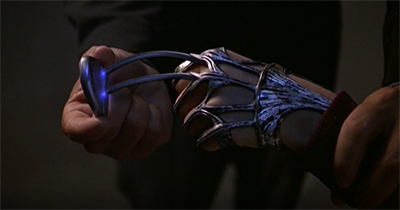
Protecting projections.
However, the seventh season pushes this idea to the fore. Body and Soul is the first episode of the seventh season to suggest a holographic revolution, but it is not the last. The Lokirrin are caught in a struggle with an unseen holographic “insurgency.” The Hirogen will face a similar threat in Flesh and Blood, Part I and Flesh and Blood, Part II. Towards the end of the season, the EMH will challenge the Federation itself to assert his individual rights in Author, Author. There is a strong recurring sense that the holograms are evolving, and deserve greater freedom.
There is, of course, something awkward in how the seventh season of Voyager frames this recurring motif, especially in both Body Soul and Flesh and Blood, Part I and Flesh and Blood, Part II. In both cases, this revolution is portrayed as brutal and violent. Flesh and Blood, Part I and Flesh and Blood, Part II portray that revolution from the inside, treating it as flawed, self-serving and hypocritical. Body and Soul does not feature any holographic characters, and is told entirely from the perspective of the organic characters who created and maintained the holographic personnel.
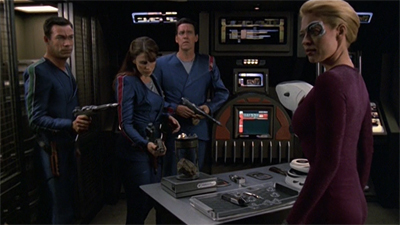
“We’re fascists. But nice fascists. We enjoy wine and cheescake, like all civilised people.”
In Body and Soul, the only aspect of the revolution that the audience sees is the body lying in the Lokirrim sick bay, those individuals victimised and brutalised by what amounts to terrorism. While the Lokirrim are not introduced as sympathetic characters, Body and Soul works hard to humanise both Ranek and Jaryn. The EMH even closes on good terms with both characters, sharing a laugh with Jaryn and telling Ranek that “aside from a few awkward moments, I enjoyed our time together.”
The only account of the conflict comes from the Lokirrim, Jaryn’s discussion of her own experiences with a holographic servant kept by her family. “We never treated him like a servant, but he turned against us anyway,” she laments. The EMH offers the weakest possible push-back, “Is it possible he felt subjugated?” Jaryn sighs, “I don’t see how. He lived his own life, pursued his own interests. He was part of our family. At least I thought he was.” The episode consistently portrays Jaryn as trustworthy and honest. The scene suggests that we should take her at her word.

A Jaryn turn.
In some ways, this serves to bring Voyager a full circle, albeit in the worst possible way. The first two seasons of Voyager focused on the Kazon, another race freed from slavery who wrought destruction on those who enslaved them. As in both Body and Soul and Flesh and Blood, Part I and Flesh and Blood, Part II, it was always very clear that Voyager‘s sympathies lay as readily with those deposed slavers rather than the enslaved. Alliances memorably featured Janeway telling a race of former slavers that “in many ways we’re in the same predicament.”
Again, a lot of this is rooted in the cultural context of Voyager, as a product of Los Angeles during the nineties. The racial and political anxieties simmering through Voyager were shaped and informed by images like the Los Angeles riots and concerns about increased gang violence in the United States as a whole. None of this is to excuse the awful politics at play here, merely to contextualise them. Voyager was always going to be wary of dispossessed groups lashing out against authority. In the early years, it is the Kazon. In the later years, it is the holograms.

Having her cake and eating it.
It makes sense that Voyager would return to these themes in its final season. After all, Kenneth Biller was responsible for fleshing out the Kazon between the first and second seasons of the show, contributing to key episodes like Initiations and Manoeuvres. With Berman and Braga focused on the development of Enterprise, Biller was charting a course for Voyager. It seems inevitable that Biller would return to that anxiety about oppressed populations rising up against their oppressors, even in the background of episodes as seemingly innocuous as Body and Soul.
Body and Soul is a clumsy and awkward episode that just about manages to hit its marks without understanding them, and which is elevated by a fantastic central performance. Like so much of the seventh season of Voyager, this is Star Trek on autopilot, hurdling through the void and trying not to crash into anything too large. Body and Soul has a few glancing blows, but nothing too damaging.
Filed under: Voyager | Tagged: Body swap, holgorams, jeri ryan, mike sussman, phyllis strong, Pon Farr, revolution, robert picardo, star trek, star trek: voyager, tone, tuvok |




















>Star Trek consistently and repeatedly refused to acknowledge the existence of same-sex relationships for fear of alienating conservative viewers. Even Deep Space Nine had to approach the issue obliquely in Rejoined and Chimera.
Yes, quite oblique. I had no idea what the subtext meant when two women on DS9 kissed. :p
The connective tissue between this & Bounty is that horny Vulcans are seen as objects of ridicule. Hey, check out these weirdos! They occasionally enjoy having sex! What a universe to live in, am I right?
Ha! But you know what I mean. Even that episode (and Chimera) had to bend over backwards to say, “this isn’t regular gay people! don’t be alarmed!”
(To be clear, I am absolutely 100% certain that Behr and the writers on Deep Space Nine would have happily included healthy and stable same-sex relationships. Evidence seems to suggest that the directive came from the top down.)
The acting is just hilarious; Ryan should have won any prize there is for it. I have rarely seen such a convincing and funny imitation on television. And there are so many good scenes with a double meaning, for instance when Sevens tells her captor she needed to keep her body in shape while giving him the already half eaten cheesecake and replicating her another one. I like humor like that. (But wait… synthehol can make you drunk?)
And I also like how the producers seem to slowly shift the focus of this last season towards the matter of Holograms and their rights and fates. I never fully understood why this matter was so different from that of AI in general, but this season makes a far better point about that than the recent “Picard” series where holograms seem to be distinct from the ban on AI/androids for really no good reason.
The final scene with Seven and the remorseful Doc is kind of nice, but cannot make up for the one detriment of this episode: The fact that indeed Seven is kind of violated by the Doctor who is, probably unintended, shown to be kind of cruel in the fact that by taking over a body (granted: a cybernetic one…) he simply relishes the opportunity. This and Tuvok’s not perfect holo-sex with the recreation of his wife seem to suggest there is an advantage of “bodies” versus their photonic imitations. This seems a bit “reactionary”, but still a lot more nuanced than the trash of last seasons “Fair Haven” which had higher immediate philosophical ambitions.
So I tend to agree with your review, Darren, but Ryan’s performance makes this clearly a highlight of an overall above average season (in my mind).
Yep, as I recall, synthahol makes you drunk until you choose to be sober, which I have never understood? Probably best not to think too hard about it that, I suspect.
I sighed with exasperation at yet another “Tuvok is out of control of his emotions!” episode. He is now firmly established as a sort of half-insane member of the crew, who alternates between total self-control and a maniac in need of help from everyone else. Almost no plot involving Tuvok doesn’t also include him in a state of unhinged expression/madness.
Jeri Ryan was fun to watch here, although I found the doctor’s actions extremely creepy and kind of gross. This gets at a problem with Star Trek’s deep infusion with Descartes-driven ideas of mind-body dualism. We see it with Tuvok (Vulcan sex seems to involve extreme telepathy, which would indicate that a hologram would be hugely inadequate). We see it here with Seven. The Doctor basically climbs ‘inside’ Seven like she is some sort of meat vehicle. It is a very unsettling philosophical view, with unrealistic outcomes.
That’s an interesting point to make about the Star Trek franchise’s ideas regarding the body/mind (or “soul”) duality. Star Trek treats the two as distinct, with the mind very much superior to the body. There are an enormous number of duplicates/clones/impersonators/shapeshifters in this franchise. The transporter as a concept demonstrates how easily the body in this universe can be taken apart and put back together, and in only a few instances is it hinted at how horrifying that could be. Many characters have gone through profound physical changes in episodes that are resolved by the end with zero long-term impacts. In short, the body is treated like a “meat vehicle”, and the mind is what really represents the identity.